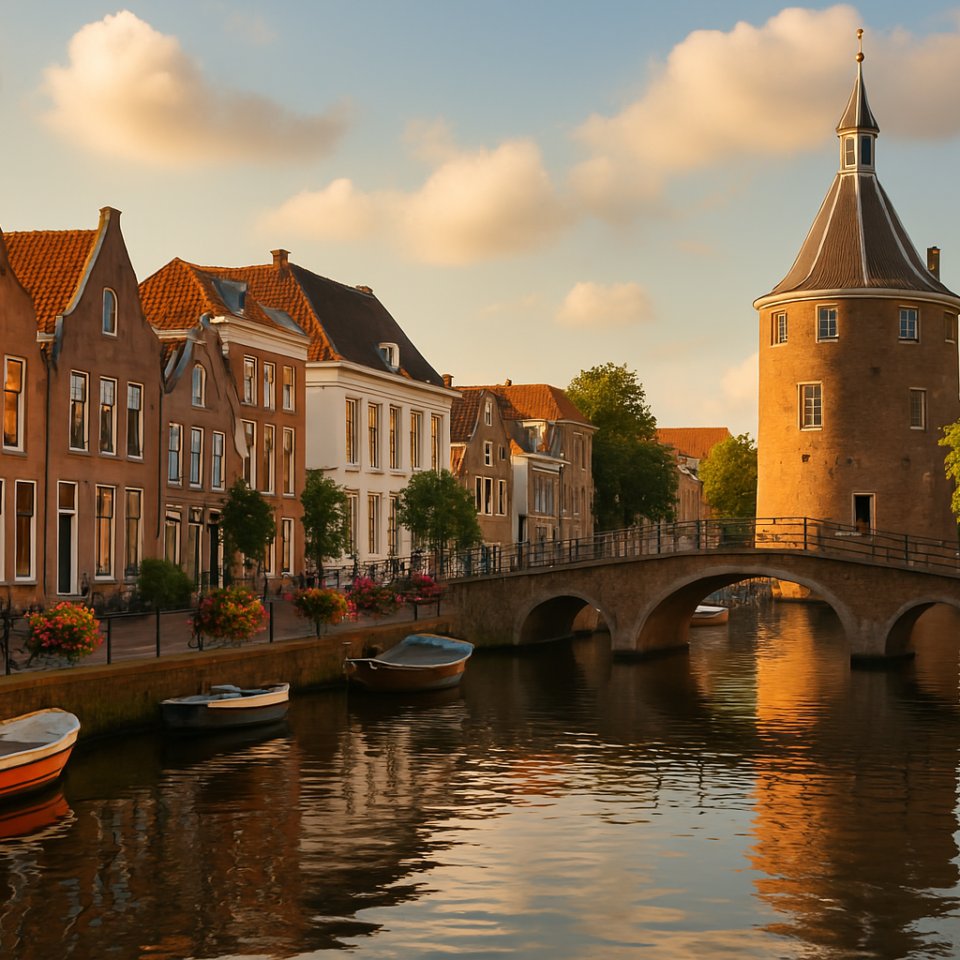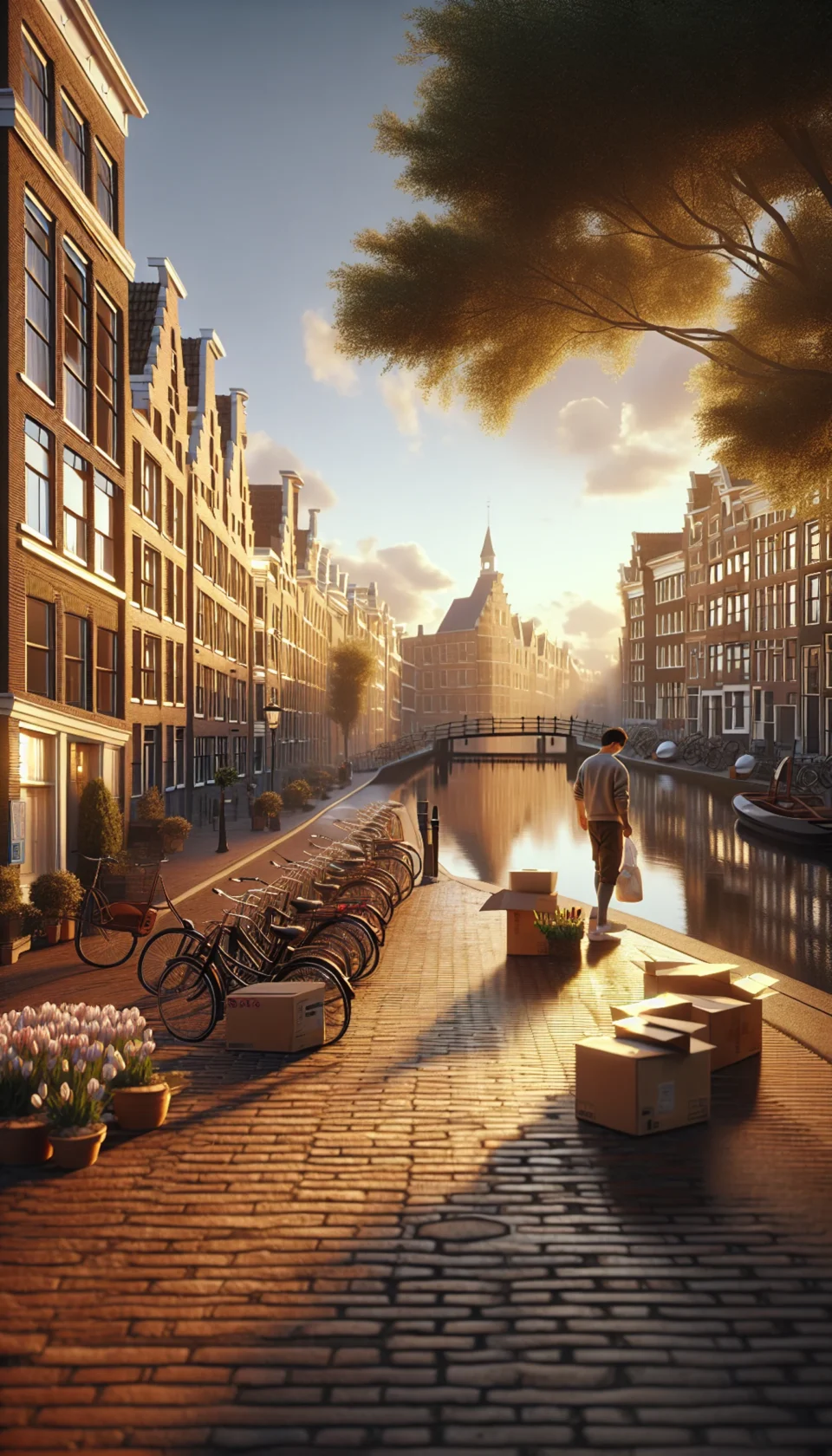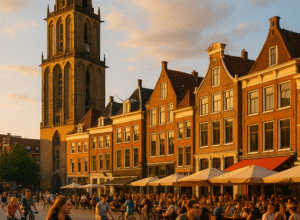Why Look Beyond Amsterdam?
When Americans dream of moving to the Netherlands, Amsterdam typically dominates the imagination. With its picturesque canals, world-class museums, and seemingly omnipresent English, the capital appears to be the obvious choice for expats seeking an easy transition into Dutch life.
While Amsterdam certainly deserves its stellar reputation, it comes with significant drawbacks: astronomical housing prices, overwhelming tourism, and a somewhat artificial “international bubble” that can keep you disconnected from authentic Dutch culture. Many Americans arrive only to discover they’re paying premium prices for a version of the Netherlands that feels curated for visitors rather than residents.
During my time in the Netherlands, I’ve discovered that some of the most rewarding expat experiences happen in cities beyond the capital. These “secondary” Dutch cities offer more accessible housing markets, tighter-knit international communities, and a more genuine immersion into Dutch life—all while maintaining excellent connectivity to Amsterdam when you need your fix of big-city amenities or international travel connections.
Let’s explore five outstanding alternatives that deserve your serious consideration if you’re planning a move to the Netherlands.
1. Utrecht: The Vibrant Heart of the Netherlands
A perfectly balanced city that blends historic charm, modern infrastructure, and an unbeatable central location.
Just 25 minutes by train from Amsterdam, Utrecht offers much of what makes the capital appealing without many of its drawbacks. As the geographical center of the Netherlands and its main transportation hub, this city of approximately 350,000 people beautifully balances historical charm with forward-thinking urban planning.
Housing Situation
Utrecht’s housing market is challenging but notably more accessible than Amsterdam’s. While rental prices have increased in recent years, you can expect to pay roughly 15-20% less than in the capital for comparable space. The surrounding areas like Leidsche Rijn offer newer developments with more square footage, making them particularly attractive to families.
Typical costs: A one-bedroom apartment in central Utrecht typically ranges from €1,000-1,400/month compared to €1,400-2,000 in Amsterdam.
International Community
Utrecht University attracts students and researchers from around the world, creating a dynamic international atmosphere. Major companies like Capgemini, Rabobank, and numerous startups maintain significant operations here, employing English-speaking internationals across various sectors.
The Utrecht Expat Center offers dedicated services for newcomers, and numerous international meetup groups organize regular events. While the expat community is substantial, it feels more integrated with local Dutch life than Amsterdam’s more segregated international scene.
Lifestyle Benefits
Utrecht’s medieval city center features distinctive split-level canals with waterside cafés and restaurants housed in former wharf cellars. The car-restricted center makes for pleasant walking, while the surrounding neighborhoods offer diverse housing options from historic homes to modern apartments.
Unlike Amsterdam’s tourist-dominated center, Utrecht maintains an authentic Dutch character with local shops, weekly markets, and community events. The celebrated TivoliVredenburg music complex hosts everything from classical concerts to electronic dance nights, while the annual Nederlands Film Festival brings cinema lovers together each September.
Transportation Connections
As the Netherlands’ main rail hub, Utrecht Centraal offers direct connections to virtually everywhere in the country, plus international service to Germany and Belgium. Amsterdam Schiphol Airport is just 30 minutes away by direct train, making international travel remarkably convenient.
Perfect For
Utrecht shines for professionals working in finance, education, or tech who want a more livable urban environment without sacrificing big-city amenities. Its strong cycling infrastructure and excellent schools also make it ideal for families seeking a balanced lifestyle.
2. Eindhoven: The Innovation Powerhouse
A tech-driven, design-forward city where the future is being built—and expats are part of it.
Often overlooked by Americans focused on the more picturesque western cities, Eindhoven in the southern province of North Brabant offers a completely different Dutch experience. This former Philips company town has transformed into a dynamic innovation ecosystem with a strong international orientation.
Housing Situation
Eindhoven offers perhaps the best value proposition of any major Dutch city for housing. Modern apartments and family homes are available at prices that would seem impossible in the Randstad (the western conurbation including Amsterdam, Rotterdam, and The Hague).
The city has invested heavily in urban redevelopment, converting former industrial areas like Strijp-S (once Philips’ radio factory complex) into vibrant mixed-use neighborhoods with distinctive architecture and creative energy.
Typical costs: A one-bedroom apartment in central Eindhoven typically ranges from €800-1,100/month—roughly half what you might pay in Amsterdam.
International Community
Eindhoven embraces its international character perhaps more enthusiastically than any Dutch city outside Amsterdam. The presence of the High Tech Campus (often called “the smartest square kilometer in Europe”), Philips, ASML, and TU Eindhoven (technical university) creates a remarkably diverse population.
The Holland Expat Center South provides comprehensive services for internationals, while The Hub offers co-working and community events specifically designed for expats. English is widely spoken, particularly in the tech and design sectors that dominate the local economy.
Lifestyle Benefits
While Eindhoven lacks the historic charm of other Dutch cities (much of it was rebuilt after WWII), it compensates with a forward-looking energy and an outstanding design scene. The annual Dutch Design Week transforms the city each October, while the GLOW light festival illuminates winter evenings with spectacular installations.
The surrounding Brabant countryside offers beautiful natural areas for hiking and cycling, while the Philips Stadium hosts PSV Eindhoven soccer matches with their passionate local following.
Transportation Connections
Eindhoven Airport provides budget flights throughout Europe, offering an alternative to Schiphol for many destinations. The central train station connects to Amsterdam in about 80 minutes, with direct service to Rotterdam, Utrecht, and other major cities.
Perfect For
Eindhoven stands out for tech professionals, engineers, and designers seeking career opportunities in innovative companies. Its relatively affordable housing and international school options also make it attractive for families, especially those with STEM-focused careers.
3. Leiden: Historic Charm with International Appeal
A picturesque university town steeped in history, yet deeply connected to today’s global networks.
Nestled between Amsterdam and The Hague, Leiden combines the intimate feel of a historic university town with the practical advantages of its location in the dense Randstad network. With around 125,000 residents, it offers a more manageable scale while remaining thoroughly connected to bigger neighboring cities.
Housing Situation
Leiden’s housing market sits in the middle range for the Randstad—more expensive than Utrecht but more accessible than Amsterdam. The historic center features classic canal houses (often divided into apartments), while surrounding neighborhoods offer a mix of pre-war and modern options.
The nearby town of Oegstgeest provides more suburban housing choices with excellent cycling connections to Leiden proper, making it popular with international families.
Typical costs: A one-bedroom apartment in central Leiden typically ranges from €900-1,300/month, with significant savings possible in surrounding towns.
International Community
Leiden University, the oldest in the Netherlands, attracts students and academics from around the world. The presence of the Leiden Bio Science Park—the largest life sciences cluster in the Netherlands—brings researchers and professionals from pharmaceutical and biotech industries.
Organizations like Expat Centre Leiden facilitate connections within the international community, which feels more academically oriented than in some other Dutch cities. The historic Pieterskerk carries special significance for Americans, as it was the worship place for the Pilgrims before their departure to America.
Lifestyle Benefits
Leiden’s compact historic center packs remarkable cultural assets into a walkable area, including excellent museums like the Rijksmuseum van Oudheden (antiquities) and the Museum De Lakenhal (Dutch masters including Rembrandt, who was born here).
The city comes alive during events like the Leiden International Film Festival and Leiden’s Ontzet (October 3rd)—a uniquely local celebration commemorating the end of the Spanish siege in 1574, featuring herring, white bread, and significant amounts of beer.
Transportation Connections
Leiden Centraal station offers direct connections to Amsterdam (25 minutes), Rotterdam (30 minutes), The Hague (10 minutes), and Utrecht (35 minutes). Amsterdam Schiphol Airport is just 15 minutes away by train, making this one of the most conveniently located cities for international travelers.
Perfect For
Leiden particularly suits academics, researchers, and professionals in science-related fields. It’s also ideal for those who appreciate cultural richness and historic character but need convenient access to Amsterdam or The Hague for work or amenities.
4. Groningen: Northern Energy with University Spirit
A youthful, bike-friendly city that offers a fresh Dutch experience far from the tourist trail.
As the main city of the Netherlands’ northern provinces, Groningen marches to its own distinct rhythm. This university city of about 200,000 people offers a completely different Dutch experience—one with lower costs, fewer tourists, and a unique cultural identity shaped by its relative isolation from the Randstad.
Housing Situation
Groningen provides perhaps the best housing value of any major Dutch university city. Both historic properties in the center and modern developments in areas like Europapark offer significantly more space for your euro than comparable properties in western cities.
The city has invested in innovative housing projects like Terra Nova with sustainable designs and community-oriented spaces. Student housing does create seasonal pressure on the rental market, but overall affordability remains a major advantage.
Typical costs: A one-bedroom apartment in central Groningen typically ranges from €700-1,000/month—substantially less than Randstad cities.
International Community
The University of Groningen, founded in 1614, draws over 30,000 students including a substantial international contingent. The Hanze University of Applied Sciences adds further diversity to the population, creating a remarkably youthful and internationally oriented atmosphere for a city of its size.
The International Welcome Center North supports newcomers with practical matters, while numerous student organizations facilitate integration. English proficiency is widespread, though learning basic Dutch will enhance your experience in local shops and with older residents.
Lifestyle Benefits
Groningen’s car-free city center creates an exceptionally pleasant urban environment dominated by cyclists and pedestrians. The main square, Grote Markt, and the iconic Martini Tower anchor a compact historical core filled with cafés, independent shops, and cultural venues.
The Groninger Museum, housed in a controversial postmodern building, showcases contemporary art and design. Music venues like Vera maintain an impressively independent cultural scene, while the surrounding countryside offers distinctive landscapes including the Wadden Sea (UNESCO World Heritage site).
Transportation Connections
While Groningen lies farther from the Randstad, the train connection to Amsterdam takes about 2 hours and 15 minutes. The city’s compact nature means most daily transportation happens by bicycle, with excellent cycling infrastructure throughout the urban area.
Perfect For
Groningen particularly appeals to students, academics, and young professionals seeking an energetic city with lower living costs. Its northern location also makes it attractive to those working remotely who prize quality of life and affordable housing above frequent access to the western urban centers.
5. Delft: Picture-Perfect with Technical Innovation
Quaint canals meet cutting-edge science in this storybook city with a practical soul.
Situated between Rotterdam and The Hague, Delft combines storybook Dutch aesthetics with a pragmatic, forward-looking mentality centered around its technical university. With approximately 100,000 residents, it offers an intimate historic center while benefiting from its position within the Randstad network.
Housing Situation
Delft’s housing market reflects its desirable location and historic character, with prices higher than in provincial cities but still more reasonable than Amsterdam. The picturesque center features classic Dutch architecture around canals and squares, while newer developments like Harnaschpolder offer contemporary housing options.
Typical costs: A one-bedroom apartment in central Delft typically ranges from €900-1,300/month, with more affordable options possible in surrounding neighborhoods.
International Community
TU Delft (Delft University of Technology) serves as the gravitational center for the city’s international community, attracting students, researchers, and faculty from around the world. Major research institutes and technology companies connected to the university further enhance the international character.
The Expat Centre Delft provides support services, while the university hosts regular international events. The presence of so many technical professionals creates a community that often feels more pragmatic and innovation-focused than those in more culturally-oriented cities.
Lifestyle Benefits
Delft’s historic center ranks among the Netherlands’ most photogenic, with the Markt square dominated by the New Church’s towering spire and the Renaissance-style City Hall. The city’s association with Delft Blue pottery creates a distinctive cultural identity, while museums like the Vermeer Centrum celebrate the city’s artistic legacy.
The technical influence balances this historical character with a forward-looking perspective evident in initiatives like Green Village, a living lab for sustainable technologies. This blend of past and future creates a uniquely balanced atmosphere rare in cities of comparable size.
Transportation Connections
Delft benefits from excellent rail connections, with Rotterdam reachable in 15 minutes, The Hague in 10 minutes, and Amsterdam in about an hour. Rotterdam The Hague Airport is just 15 minutes away by car, providing European connections, while Schiphol Airport can be reached in 40 minutes by train.
Perfect For
Delft particularly suits engineers, architects, and technical professionals seeking a beautiful living environment with strong innovation ecosystems. Its manageable scale and picturesque character also make it appealing to families and those who want historic Dutch aesthetics without tourist crowds.
Making Your Decision: Factors Beyond the Obvious
When considering these alternatives to Amsterdam, American expats should weigh several factors beyond just housing costs and job opportunities:
Regional Mentality Differences
Dutch regions have distinct cultural characteristics that affect daily life. The northern provinces (including Groningen) typically offer a more relaxed pace and straightforward communication style. The southern regions (where Eindhoven is located) are often described as more convivial and lifestyle-oriented, with influences from neighboring Belgium. Understanding these regional differences can help you find a cultural fit that matches your personality.
International School Availability
For families with children, access to international education often becomes a decisive factor. Utrecht, Leiden, and Delft benefit from their proximity to international schools in the wider Randstad area, while Eindhoven has its own International School. Groningen offers the International School Groningen, though with more limited capacity than those in the western Netherlands.
Industry Clusters
Each city has distinctive economic strengths: Leiden excels in life sciences, Eindhoven in high-tech manufacturing and design, Utrecht in financial services and digital media, Delft in sustainable technology, and Groningen in energy research and digital startups. Aligning your career with these specializations can significantly improve your professional prospects.
Language Immersion Opportunities
While all these cities have strong English proficiency, they offer different environments for learning Dutch. Groningen’s relative isolation often provides better immersion opportunities, while areas with higher concentrations of internationals might make daily life easier but Dutch acquisition more challenging.
Conclusion: Embracing Authentic Dutch Life
Choosing a Dutch city beyond Amsterdam doesn’t mean settling for second best—it means opting for a more authentic, often more livable experience that better reflects everyday Dutch life. Whether you’re drawn to Utrecht’s central position, Eindhoven’s innovation culture, Leiden’s academic atmosphere, Groningen’s youthful energy, or Delft’s technical-historical balance, these cities offer distinctive pathways into Dutch society that the capital cannot match.
My experience has shown that Americans who choose these “secondary” cities often develop deeper connections to Dutch culture, more diverse friendship circles, and a greater sense of belonging than those who remain within Amsterdam’s international bubble. They also typically enjoy better housing value, more space, and less exposure to the challenges of overtourism.
The Netherlands offers remarkable quality of life throughout the country, not just in its famous capital. By expanding your horizons to include these alternative cities, you might discover the perfect Dutch home you never knew you were looking for.
Have you lived in one of these Dutch cities as an American expat? Share your experiences in the comments! Or if you’re planning a move to the Netherlands, which of these cities seems most appealing to your situation?








